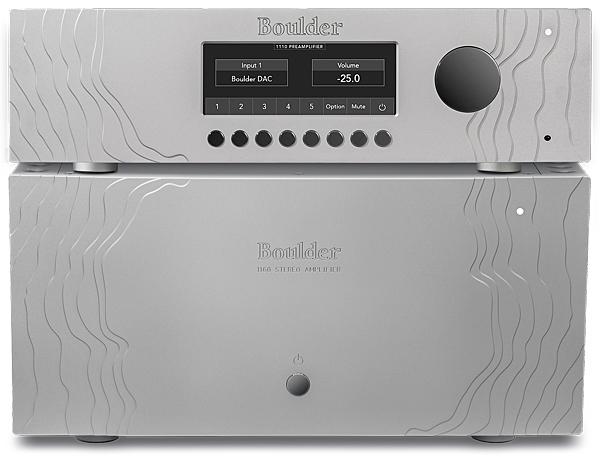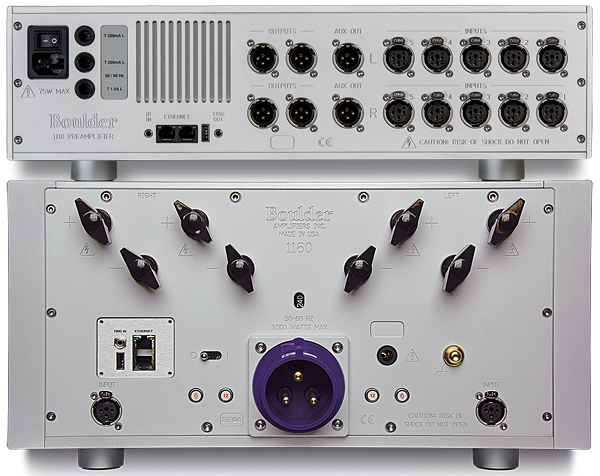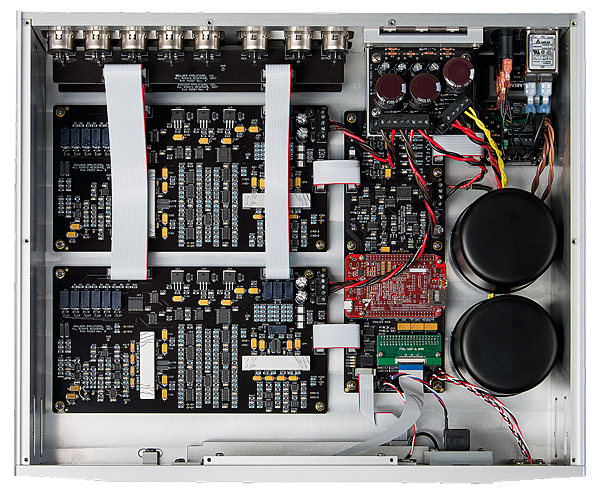Boulder 1110/1160 Pre/Power Amplifier

 The no-nonsense mountain-inspired aesthetic is unmistakable, but despite the heady pricing this pre/power amp combo is from one of Boulder's more affordable ranges
The no-nonsense mountain-inspired aesthetic is unmistakable, but despite the heady pricing this pre/power amp combo is from one of Boulder's more affordable ranges
It's the style of the Boulder 1100 series amplification that grabs you first – very different from the common image of US-made high-end hi-fi, even if the £30,000 1160 stereo power amp lives up to at least some of the stereotype with its 61.2kg mass. Instead of the usual scattergun buttons, grab-handles and menacing – not to mention finger-slicing – heatsinks so common in products of this type, seemingly built with no concession to domestic acceptability, the Boulder power amp and its matching £22,500 1110 line-only preamp have a much softer look.
In fact, the company's industrial designers have got a bit playful, with what look like geographic contour-lines machined into the front panels. In fact that's just what they are – a topography of the 2000m+ tall Flagstaff Mountain, around a 30-minute drive from the company's manufacturing centre.
Simple Does It
Weight aside, these Boulder amplifiers combine simplicity of initial set-up and operation with the kind of solidity of build you'd expect from a brand with its roots in pro audio, where durability and reliability are vital. That explains a lot about the no-frills design of these two components.
The 1110 preamp is little more than five sets of inputs – on balanced XLRs only – and three sets of outputs, two main and one auxiliary, plus source selection and Boulder's own balanced volume control. If you want to play records, you're going to need an external phono stage: there's the 'entry-level' 508 at £6150 [HFN Jul '19] or Boulder's matching 1108 at £20,500.

Well, things are almost that simple. In fact, each input can be adjusted for polarity (as can the output of the whole preamp), trim (by up to 25dB) and balance (by 12dB in either direction), or converted into a unity-gain passthrough for use with a home cinema processor. It's also possible to connect the preamp to a computer for detailed set-up, such as changing the name-labels on each input.
Before you get all streaming-happy at the presence of a pair of Ethernet ports on the 1110 (and 1160), 'set-up' is all they're for, along with IP control (including other Boulder components via Boulder Net connectivity) in a custom installation. This connection also allows for 'over the air' firmware upgrades.
Driven By Logic
And while that large volume control looks basic, Boulder cautions that it's actually optically controlled, and not click-stopped at all. Says the manual, 'The volume knob must be given respect as it can rotate quickly and has ability to raise the volume very fast'. That might explain why this chromed control disc is sunk into the fascia – you know, just in case…
Within, the 1110 uses an ARM processor for all those set-up and operational functions, while the audio is carried on dual-mono boards, employing the company's 983 gain stage, designed for 'excellent buffering and current drive for long cable runs'. So there should be no problem doing the 'long interconnects, short speaker cables' thing.
The 1160 power amplifier is far from compact, but the impact of its bulk is softened by its design, not least that 'mapping' on the front panel and the treatment of the heatsinking to each side. Less understated is the massive mains input connector to the rear, which looks like it belongs on an industrial transformer for outdoor power tools, and the twin sets of substantial wing-screws on the output terminals.

Balanced All The Way
The headline specification here is the 300W output – a figure the amplifier obliterated in PM's lab testing. All this is delivered from circuitry that uses the same gain stage found in the preamp, and is dual-mono in design, fully balanced and powered by twin DC-filtered power supplies ensconced within a welded steel case. Inputs are, of course, on XLRs only, and the whole amp is microprocessor-monitored against over-voltage/current or excessive temperature. Despite the prodigious power, there's no forced thermal management here, meaning it's all down to good old convection.
By the way, if you'd like the performance of the 1160 but just haven't got space, the company offers an alternative in a more compact form. The 1161 is said to have 'the same operational feature-set as its larger brother', but reduces the power to a claimed 150W, the footprint to the same as that of the 1110 preamp, and the weight to a more manageable 24.5kg. It's yours for a price closer to that of the 1110, too, at a still-princely £23,500.
![]() Massive Attack
Massive Attack
With the Boulder 1110/1160 set up in the HFN reference system – Melco/dCS front-end [HFN Feb '18], B&W 800 D3 speakers [HFN Oct '16] – it was necessary to wind down the output level of the DAC to make the volume levels more controllable (which we could also have done with the preamp's input trims). But even then, and using the neat little Boulder remote handset to adjust levels, it was noticeable just how quickly the amplifiers went from comfortable to full-on attack.























































